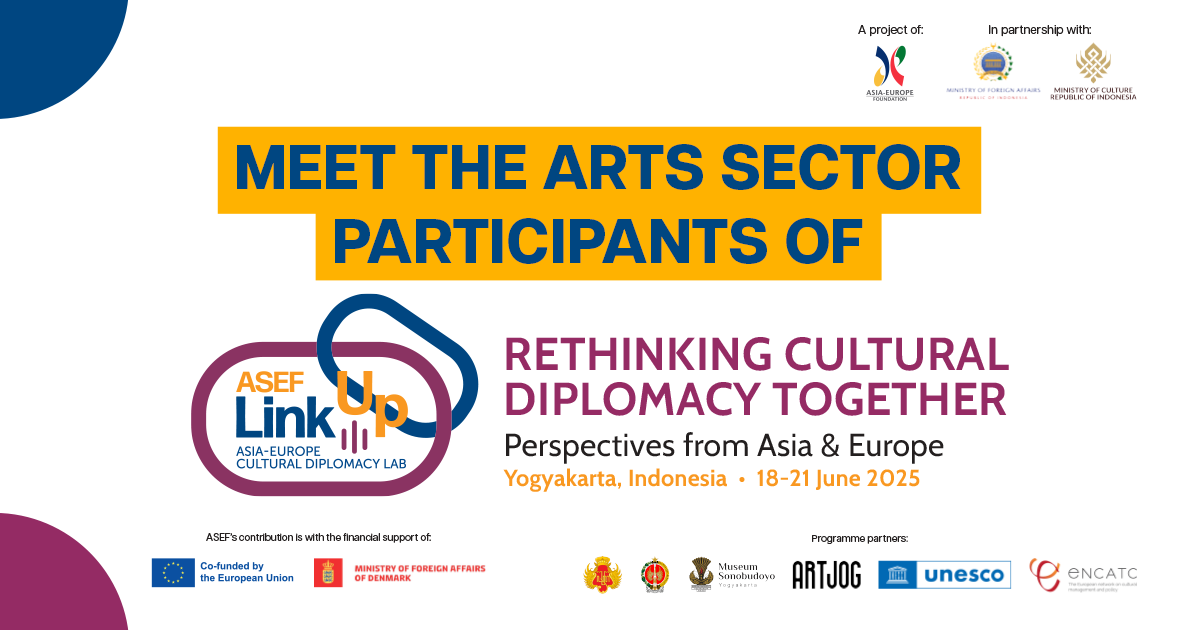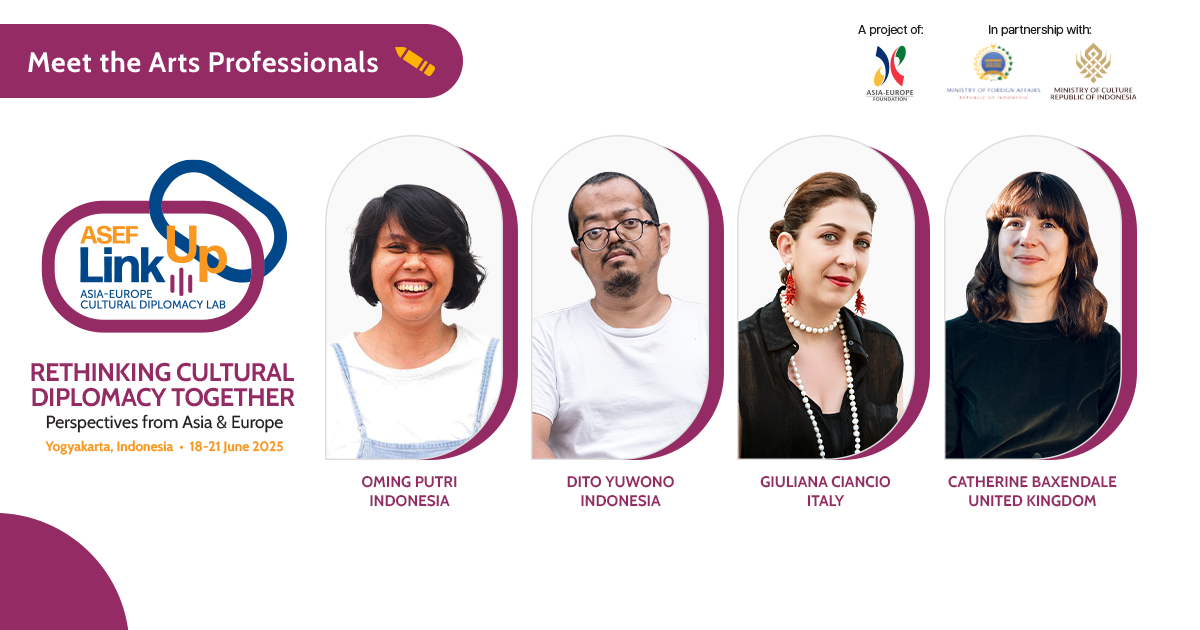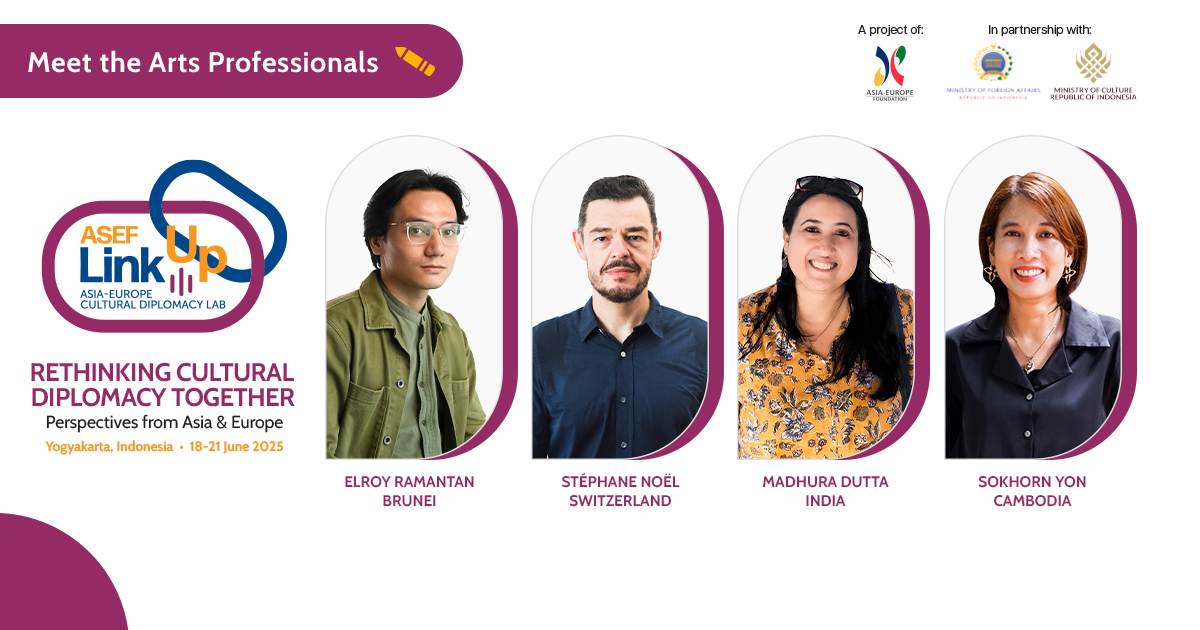ASEF LinkUp 2025 | Perspectives from the Arts Sector

The 2025 edition of ASEF LinkUp | Asia-Europe Cultural Diplomacy Lab is taking place in Yogyakarta, Indonesia from 18 to 21 June!
Organised in partnership with the Ministry of Foreign Affairs and Ministry of Culture of Indonesia, with the support of the Yogyakarta Royal Palace, Regional Government of the Special Region of Yogyakarta, Sonobudoyo Museum, ArtJog Festival, UNESCO Jakarta and the European network on cultural management and policy, ENCATC, this edition centers on the theme of "Rethinking Cultural Diplomacy Together”.
Gotong royong in cultural diplomacy
This year’s ASEF LinkUp delves deeper into the issue of collective responsibility. Drawing inspiration from Indonesia’s “gotong royong” ethos, the term translates to a collaborative way of working together in the spirit of goodwill and reciprocity, knowing that one can count on the support of others working towards a communal goal.
In the past decade, we have witnessed the rise of complex challenges and changes from climate disruption to digital development and global political unrest and conflict. The role of cultural diplomacy has hence become more critical.
There is no question that the arts and culture can provide a means to gain a better understanding of one another and help transcend economic, social, digital, cultural and geographical divides. Yet are we making the most in positioning culture as a key driver for mutual understanding? How can the arts and culture sector, governmental and institutional representatives engage more effectively in nurturing international cultural relations, grounded in diversity, solidarity, mutuality and equality?
To reflect on these global issues, ASEF LinkUp 2025 will gather eight arts sector participants from Brunei Darussalam, Cambodia, India, Indonesia, Italy, Switzerland and the United Kingdom together with nine government representatives. The selected participants will bring insights from their work and region on the current challenges in collective cultural diplomacy.
The Indonesian perspective
Indonesia is known for its active, resourceful and vibrant arts scene. Local arts organisations and artistic initiatives often meld creative engagement with social, cultural and environmental issues. There is much experimentation and diversity, and that is what makes the Indonesian context exciting.
However, equitable and open participation amongst institutions, communities and individuals remain a hurdle in international cultural cooperation. Participants in Indonesia highlight the lack of recognition and limitations of artistic freedom as a barrier. As defined by UNESCO, artistic freedom embodies a number of rights protected under international law, including the right to create without censorship and intimidation and the right to participate in cultural life.
Artists often face constraints ‘shaped by institutional, state, or funding agendas’. Freedom often comes with ‘implicit terms and conditions’, ‘making it essential to critically and continuously assess said source and agenda.’ - Dito Yuwono, visual artist, curator and co-director of Cemeti Institute for Art and Society
‘For cultural diplomacy to be truly impactful, it must go beyond representation and embrace structural change by amplifying the voices of cultural actors, supporting their rights, and aligning national narratives with the lived realities of those sustaining culture on the ground.’ - Oming Putri, organisational development and partnership manager of Koalisi Seni,
The lack of recognition of artistic freedom as a necessity often result in policies that overlook the need to uphold freedom of expression and creativity, which can potentially weaken the diversity of cultural expressions and voices in cultural diplomacy.
Breaking structural barriers
Those in the arts and cultural fields are witnessing fragmentation and increased competition for funding, resources and more.
Unsustainability in the sector has been brought to the forefront:
‘The dominance of a project-based logic, while offering opportunities for experimentation, has also contributed to ‘short-termism’, competition over collaboration, and a sense of physical and mental fatigue among practitioners and funders.’ as shared by Dr Giuliana Ciancio, cultural manager, researcher and co-founder of Liv.in.g. - Live Internationalisation Gateway based in Italy.
Catherine Baxendale, executive producer of Invisible Flock echoed this.
‘Organisations are pitching against one another rather than engaging in long form relationship development.’ - Catherine Baxendale
This situation calls for discussions on how to reinvest in a long-term vision that places genuine, meaningful and long-term engagement at the heart of international cultural exchanges. How can we shift the current narrative to one that leads to a more mutually beneficial cultural ecosystem.

On market pressures and artistic integrity
Artists and cultural professionals do not operate in a vacuum. Local societal norms and laws, expectations of funders and commercial priorities often pressure artists and arts and cultural professionals from the two regions to adapt their work.
‘Different set of values create different KPIs that are often hard to all meet, or require a lot of detailed explanation.’ - Stéphane Noël, producer and curator of contemporary performing arts
Sokhorn Yon, Director of Programmes at the Cambodian Living Arts (CLA) offers some insights from managing grants. For some artists, the application process and reporting can be administrative heavy.
‘Institutional stakeholders often expect formalisation, alignment with international agendas, or rigid reporting mechanisms. This can unintentionally exclude underrepresented or marginalised artists.’ - Sokhorn Yon
One other challenge also lies in encouraging artistic expression while navigating various socio-political sensitivities.
‘Societal norms and laws, particularly regarding LGBTQIA+ rights and the representation of marginalised communities, create significant obstacles to fostering open dialogue and collaboration.’ - Elroy Ramantan, a Bruneian curator, artist, and activist using art as a tool for empowerment and social advocacy.
As such, while rethinking cultural diplomacy, consider an inclusive definition of arts and cultural professionals (for instance including those with less visibility), developing projects that are open, communication and cultural sensitivity.
“Mediating these very different understandings of the world and helping to establish a common vocabulary so that our conversations can make sense to all stakeholders” can be a form of advocacy for collective responsibility in cultural diplomacy, Stéphane adds.

Exclusions of culture
Culture is often sidelined in global relations and policy agendas, as exemplified by the few references to culture in the Sustainable Development Goals (SDGs). However, there is extensive evidence that cultural activities and cultural relations, can make significant contributions to many global challenges.
‘Culture is mostly treated as a stand-alone discipline or goal rather than considering it instrumental in broad-based, people-centric development.’ - Dr Madhura Dutta, a culture and development specialist from India
Bridging this disconnect requires a multi-directional dialogue – from connections with other sectors (e.g. science, environment, social) to creating inclusive spaces that include voices of the indigenous communities. ‘Overcoming siloed sectoral work is essential to leverage collaborative opportunities for shared development goals.’ emphasises Madhura.
What role could ASEF LinkUp play?
In an age of speed and constant volatility, ASEF LinkUp participants collectively underscore:
- the need for the involvement of local communities and those with less representation,
- frameworks that recognise artistic freedom,
- supportive environments that help support a long term perspective in cultural diplomacy
With the common dilemmas and practical challenges raised by the participants, it is hoped that the gathering between the two sectors during ASEF LinkUp 2025 will provide an opportunity to conceive shared solutions for a more coordinated and inclusive environment for cultural cooperation across borders.
Stay tuned for more conversations about this year's #ASEFLinkUp by following ASEF culture360's social media channels - Facebook, X and Instagram.
